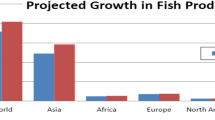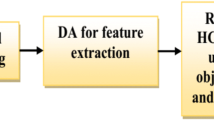Abstract
Biologists and marine ecologists' vital task is to classify fish species regularly to assess the relative profusion of fish species in their native environments and track population fluctuations. Traditional fish species classification procedures were time-consuming, labor-intensive, and costly. Consequently, an automated method is required, although improving its effectiveness remains a challenge. This research proposed a Modified Convolutional Neural Network (MCNN)-based on different classifications of fish species to augment the proposed methodology’s performance. Pre-processing, segmentation, feature extraction, feature optimization, and classification are the five phases in the proposed scheme. The input image is enhanced by using Thinning operation with Hit Miss function in the preprocessing stage. From the image, fish is segmented using Region of Interest and Hadamard Control Firefly Algorithm (HCFA). By using HCFA, the boundary is selected and the opted boundary is extracted using a canny edge detector. The Speeded Up Robust Feature feature is extracted from the segmented part after the categorization of fish. By considering classification accuracy as the fitness function, the feature is optimized by wielding the same HCFA. MCNN classifies the different fish species by giving the obtained feature as input to it. The proposed system encompassed ‘5’ diverse species and a total of 2000 images of every fish kind along with were classified. Grounded on the performance metrics, the proposed methodology’s performance is analogized with the prevailing research methodologies. This system acquired 97.55% accuracy; thus, it is suited perfectly for the fish species classification.











Similar content being viewed by others
Availability of data and materials
Data sharing is not applicable to this article as no datasets were generated or analyzed during the current study.
Abbreviations
- MCNN:
-
Modified convolutional neural network
- THM:
-
Thinning with hit miss
- ROI:
-
Region of Interest
- HCFA:
-
Hadamard control firefly algorithm
- SURF:
-
Speeded up robust feature
- ML:
-
Machine learning
- FCL:
-
Fully connected layer
- CL:
-
Convolutional layer
- FC:
-
Fish classification
References
Adiwinata Y, Sasaoka A, Bayupati IPA, Sudana O (2020) Fish species recognition with faster r-cnn inception-v2 using qut fish dataset. Lontar Komput J Ilm Teknol Inf 11(3):144–153
Al Smadi A, Mehmood A, Abugabah A, Almekhlafi E, Al-smadi AM (2020) Deep convolutional neural network-based system for fish classification. Int J Electr Comput Eng 12(2):1–15
Allken V, Handegard NO, Rosen S, Schreyeck T, Mahiout T, Malde K (2018) Fish species identification using a convolutional neural network trained on synthetic data. ICES J Mar Sci 76(1):342–349
Alsmadi MK (2019) Hybrid genetic algorithm with tabu search with back-propagation algorithm for fish classification determining the appropriate feature set. Int J Appl Eng Res 14(23):4387–4396
Alsmadi MK, Almarashdeh I (2020) A survey on fish classification techniques. J King Saud Univ Comput Inform Sci. https://doi.org/10.1016/j.jksuci.2020.07.005
Fouad MM, Zawbaa HM, Gaber T, Snasel V, Hassanien AE (2015) “A fish detection approach based on bat algorithm”. In: The 1st International Conference on Advanced Intelligent System and Informatics, 10 November, BeniSuef, Egypt.
Freitas U, Pache M, Goncalves W, Matsubara E, Sabino J, SantAna D, Pistori H (2020) “Analysis of color feature extraction techniques for Fish Species Identification”. In: XVI Workshop de VisaoComputacional.
Hasija S, Buragohain MJ, Indu S (2017) “Fish species classification using graph embedding discriminant analysis”. In: International Conference on Machine Vision and Information Technology (CMVIT), pp 17–19 February, Singapore.
Iqbal MA, Wang Z, Ali ZA, Riaz S (2021) Automatic fish species classification using deep convolutional neural networks. Wirel Personal Commun 116:1043–1053
Jalala A, Salman A, Mian A, Shortis M, Shafait F (2020) Fish detection and species classification in underwater environments using deep learning with temporal information. Eco Inform 57:1–13
Jin L, Jiong Yu, Yuan X, Xusheng Du (2021) Fish classification using dna barcode sequences through deep learning method. Symmetry 13(9):1–16
Khalifa NEM, Taha MHN, Hassanien AE (2018) “Aquarium family fish species identification system using deep neural networks”, 1st edn. Springer, ISBN: 978–3–319–99009–5.
Lathifah HM, Novamizanti L, Rizal S (2020) “Fast and accurate fish classification from underwater video using you only look once”. In: IOP Conference Series Materials Science and Engineering, 2–3 September, Purbalingga, Indonesia.
Montalbo FJP, Hernandez AA (2019) “Classification of fish species with augmented data using deep convolutional neural network”. In: IEEE 9th International Conference on System Engineering and Technology (ICSET), 7 October, Shah Alam, Malaysia.
Murugaiyan JS, Palaniappan M, Durairaj T, Muthukumar V (2021) Fish species recognition using transfer learning techniques. Int J Adv Intell Inform 7(2):188–197
Ogunlana SO, Olabode O, Oluwadare SAA, Iwasokun GB (2015) Fish classification using support vector machine. Afr J Comput ICT 8(2):75–82
Park J-H, Choi Y-K (2020) Efficient data acquisition and cnn design for fish species classification in inland waters. J Inf Commun Converg Eng 18(2):106–114
Prasetyo E, Suciati N, Fatichah C (2021) Multi level residual network VGGNet for fish species classification. J King Saud Univ Comput Inform Sci. https://doi.org/10.1016/j.jksuci.2021.05.015
Rathi D, Jain S, Indu S (2017) “Underwater fish species classification using convolutional neural network and deep learning”. In: Ninth International Conference on Advances in Pattern Recognition (ICAPR), pp 27–30, Bangalore, India.
Rauf HT, Lali IU, Zahoor S, Shah SZH, Rehman AU, Bukhari SAC (2019) Visual features based automated identification of fish species using deep convolutional neural networks. Comput Electron Agric 167:1–17
Rodrigues MTA, Freitas MHG, Padua FLC, Gomes RM, Carrano EG (2015) Evaluating cluster detection algorithms and feature extraction techniques in automatic classification of fish species. Pattern Anal Appl 18(4):783–797
Salman A, Jalal A, Shafait F, Mian A, Shortis M, Seager J, Harvey E (2016) Fish species classification in unconstrained underwater environments based on deep learning. Limnol Oceanogr Methods 14(9):570–585
Shah SZH, Rauf HT, IkramUllah M, Khalid MS, Farooq M, Fatima M, Bukhari SAC (2019) Fish pak fish species dataset from pakistan for visual features based classification. Data Brief 27:1–11
Tharwat A, Hemedan AA, Hassanien AE, Gabel T (2018) A biometric-based model for fish species classification. Fish Res 24:324–336
Waldchen J, Mader P (2018) Machine learning for image based species identification. Methods Ecol Evol 9(11):2216–2225
Acknowledgements
We thank the anonymous referees for their useful suggestions.
Funding
This work has no funding resource.
Author information
Authors and Affiliations
Contributions
All authors contributed to the study conception and design. Material preparation, data collection and analysis were performed by PP, CDS. The first draft of the manuscript was written by PP and all authors commented on previous versions of the manuscript. All authors read and approved the final manuscript.
Corresponding author
Ethics declarations
Conflict of interest
The authors declare that they have no conflict of interest.
Ethical approval
This article does not contain any studies with human participants or animals performed by any of the authors.
Consent of publication
Not applicable.
Additional information
Publisher's Note
Springer Nature remains neutral with regard to jurisdictional claims in published maps and institutional affiliations.
Rights and permissions
Springer Nature or its licensor (e.g. a society or other partner) holds exclusive rights to this article under a publishing agreement with the author(s) or other rightsholder(s); author self-archiving of the accepted manuscript version of this article is solely governed by the terms of such publishing agreement and applicable law.
About this article
Cite this article
Prasenan, P., Suriyakala, C.D. Novel modified convolutional neural network and FFA algorithm for fish species classification. J Comb Optim 45, 16 (2023). https://doi.org/10.1007/s10878-022-00952-0
Accepted:
Published:
DOI: https://doi.org/10.1007/s10878-022-00952-0




